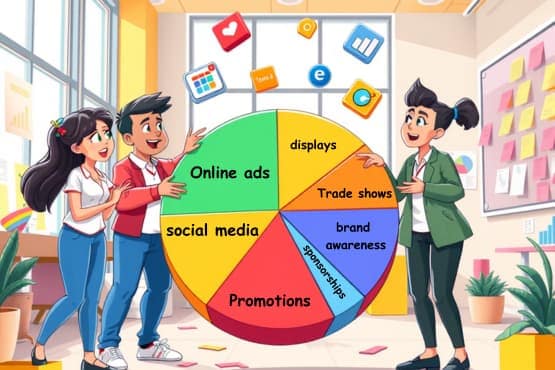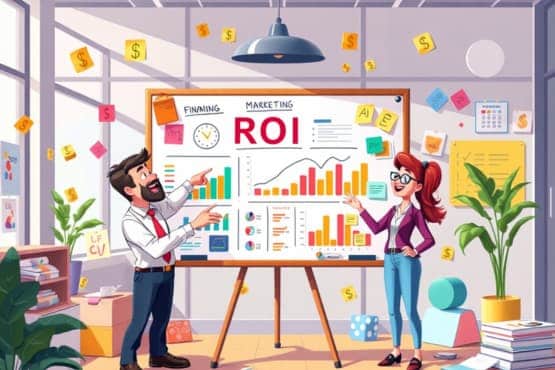Are you struggling to maximize your trade marketing ROI? Are you overspending on ineffective trade shows or struggling to balance online and offline promotions? You’re not alone. According to a recent study by Nielsen, approximately 25% of trade marketing budgets are misallocated, leading to wasted spend and missed opportunities.
To help you overcome these challenges, we’ve developed a comprehensive Trade Marketing Budget Optimization Toolkit. This resource includes channel allocation calculators, ROI forecasting templates, and more. We’ll reference this toolkit throughout the article to help you apply the strategies we discuss.
This comprehensive guide will explore data-driven strategies to optimize your trade marketing budget across channels, helping you avoid common pitfalls and drive measurable results.
Key Takeaways
- Strategic budget allocation can boost revenue by up to 3% without increasing spend.
- Data-driven decision-making using AI tools can improve trade promotion ROI by 20-25%
- Balancing digital and traditional channels is crucial, with e-commerce seeing a 30% budget increase post-COVID
- Continuous performance monitoring enables agile budget adjustments, improving efficiency by up to 15%
- Advanced analytics tools provide deeper insights, reducing misallocation of trade spend by 25%
2. Setting Up a Data-Driven Trade Marketing Budget
Creating an effective trade marketing budget requires a strategic, data-centric approach. Here’s a framework to get you started:

2.1 Analyze Historical Data
Use advanced analytics tools to review past performance. Look for patterns in channel effectiveness and ROI. Tools like Nielsen’s Retail Measurement Services can provide valuable insights into historical performance across different retail channels.
2.2 Set SMART Objectives
Define Specific, Measurable, Achievable, Relevant, and Time-bound goals. For example: “Increase incremental sales by 15% through digital trade promotions in Q3.”
2.3 Assess Market Conditions
Consider factors like competition, consumer trends, and economic indicators. The IRI Market Advantage platform offers real-time market data to help inform your decisions.
2.4 Choose a Budgeting Method
Select an appropriate framework. Here’s a comparison:
| Method | Pros | Cons |
|---|---|---|
| Zero-based budgeting | Encourages critical evaluation of all expenses | Time-consuming, may overlook historical successes |
| Performance-based budgeting | Ties spending directly to outcomes | It can be complex to implement, requires robust tracking |
| Historical-based budgeting | Simple, based on past performance | May perpetuate inefficiencies |
2.5 Allocate Funds
Based on your analysis and objectives, distribute your budget across different channels and initiatives. Our Toolkit’s Channel Allocation Calculator can help you optimize this distribution.
2.6 Plan for Agility
Set aside 10-15% of your budget for rapid reallocation based on real-time performance data. This approach, recommended by McKinsey & Company, allows for quick adaptation to market changes.
3. Channel Allocation Strategies:
Balancing your trade marketing budget across various channels is crucial for maximizing reach and effectiveness. Here’s an overview of common channels and their typical metrics:
To optimize channel allocation:

- Implement A/B Testing: Compare promotional strategies to identify the most effective approaches. For example, test varying discount levels or promotion durations to find the sweet spot for your products.
- Use Multi-Touch Attribution: Implement advanced attribution models to understand how different channels contribute to the customer journey. Google Analytics 360 or Adobe Analytics can help with this complex analysis.
- Prioritize High-ROI Channels: Based on your data analysis, allocate more budget to channels consistently delivering solid returns. However, maintain a presence in other channels to ensure a balanced approach.
- Adapt to Market Trends: Stay flexible to shift funds as consumer behaviours change. For instance, many CPG brands have increased their e-commerce budgets by 30-40% in response to the post-COVID digital shift, according to a report by eMarketer.
Trade Marketing Budget Optimization Tool
4. Advanced ROI Measurement in Trade Marketing
Accurately measuring ROI is essential for optimizing your trade marketing budget. Let’s explore some advanced metrics and calculation methods:

Retailer Growth Contribution (RGC):
RGC = (Retailer's Sales Growth / Total Sales Growth) * 100This metric helps you identify which retail partners drive the most growth, allowing for more targeted budget allocation.
Incremental Sales per Dollar Spent (ISPD):
ISPD = (Incremental Sales - Promotional Cost) / Promotional CostThis metric clearly shows the direct return on your promotional investments.
Customer Lifetime Value (CLV) in Trade Marketing:
CLV = (Average Purchase Value * Purchase Frequency * Customer Lifespan) - Customer Acquisition CostBy considering CLV, you can justify higher upfront costs for promotions that drive long-term customer relationships.
Trade Spend Efficiency (TSE):
TSE = Incremental Profit / Trade SpendThis metric helps you understand how efficiently your trade spend generates additional profit.
5. Optimizing Trade Marketing Spend with Advanced Techniques

To continuously improve your trade marketing ROI:
- Leverage AI-Driven Tools:
- For large enterprises: Utilize advanced trade promotion management (TPM) software like Accenture’s Cloud TPM or UpClear’s BluePlanner. These tools use machine learning to predict promotion outcomes and suggest optimal spending.
- For small to medium-sized businesses: Consider more affordable options like Salesforce’s Trade Promotion Management solution or Flintfox’s RMx Suite, which offer scalable features suitable for growing businesses.
- Implement Real-Time Monitoring: Use digital dashboards to track real-time key performance indicators (KPIs). This allows for agile budget adjustments during campaigns. Tools like Tableau or Microsoft Power BI can help create custom dashboards for your needs.
- Explore Blockchain for Transparency: While emerging, blockchain technology promises to improve transparency in trade spend and reduce fraud. IBM’s Food Trust network is an example of how blockchain is applied in the CPG industry.
- Personalize at Scale: Use data analytics to create hyper-targeted promotions. For example, a beverage company used AI to analyze weather patterns and local events, adjusting real-time digital ad spending to capitalize on demand spikes.
6. Case Studies: Successful Trade Marketing Budget Optimization
6.1 Global Beverage Company Embraces AI
Company: A leading multinational beverage corporation with a presence in over 200 countries. Challenge: Inefficient trade spend allocation leads to suboptimal ROI.
Solution: Implemented an AI-driven trade promotion optimization tool.
Results:
| Metric | Before | After | Improvement |
|---|---|---|---|
| Promotion ROI | 0.8 | 1.2 | 50% |
| Budget Allocation Efficiency | 70% | 85% | 21.4% |
| Time Spent on Planning | 20 hrs/week | 8 hrs/week | 60% reduction |
Key steps taken:
- Integrated historical sales data with external factors (weather, local events)
- Used machine learning to predict promotion outcomes
- Implemented real-time budget reallocation based on performance
6.2 CPG Brand Masters Omnichannel
Company: A mid-sized CPG brand specializing in organic snacks primarily sold in the United States. Challenge: Struggling to adapt to changing consumer shopping behaviours post-pandemic.
Solution: Overhauled its trade marketing strategy to align with omnichannel shopping behaviours.
Results:
| Channel | Before | After | Result |
|---|---|---|---|
| In-store | 70% | 50% | -5% in-store sales |
| E-commerce | 20% | 35% | +40% online sales |
| Social Media | 10% | 15% | +25% engagement |
Overall, the company saw a 15% increase in total sales and a 22% improvement in marketing ROI.
Key strategies:
- Implemented cross-channel attribution modeling
- Created unified customer profiles for personalized promotions
- Developed an agile budget allocation system, reallocating funds bi-weekly based on performance
7. Trends Reshaping Trade Marketing Budgets

- AI and Predictive Analytics:
- According to a survey by Deloitte, 62% of CPG companies plan to increase investment in AI for trade marketing over the next three years.
- Predictive models are improving forecast accuracy by up to 30%, as reported by McKinsey & Company.
- Shift to E-commerce:
- Post-COVID, e-commerce budgets have increased by an average of 30% across industries, based on data from eMarketer.
- According to Forrester Research, click-and-collect models are seeing a 50% year-over-year growth in many markets.
- Personalization at Scale:
- Brands using advanced personalization report 5-15% increases in revenue, as noted in a study by Boston Consulting Group.
- According to Epsilon research, 80% of consumers are likelier to purchase from brands offering personalized experiences.
- Sustainability Focus:
- 65% of consumers say they want to buy from purpose-driven brands, based on a report by Accenture.
- According to Nielsen’s Global Corporate Sustainability Report, sustainable trade marketing initiatives are seeing 25% higher engagement rates.
8. Steps You Can Take
Optimizing your trade marketing budget across channels is no longer optional—it’s necessary to stay competitive. You can significantly improve your ROI and drive sustainable growth by leveraging data-driven insights, embracing new technologies, and maintaining agility in your budget allocations.
Ready to transform your trade marketing strategy? Here are some immediate steps you can take:
- Evaluate your last quarter’s trade promotions using our ROI calculator from the Toolkit.
- Conduct an audit of your channel allocation and compare it to industry benchmarks.
- Explore AI-driven tools that fit your business size and needs.
- Set up a real-time monitoring dashboard for your key performance indicators.
Don’t let another quarter go by with misallocated budgets. Take action today and start seeing accurate results in your trade marketing efforts.
Remember, optimizing your trade marketing budget is an ongoing process. Stay informed about industry trends, continuously analyze your performance data, and be ready to adapt your strategies as the market evolves. With the right approach, you can turn your trade marketing budget into a powerful driver of growth and profitability.




